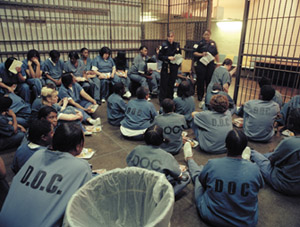 |
|
|||||||||
|
Since the 1980s the number of women sent to prison has increased dramatically—by roughly 10 percent per year, according to U.S. Department of Justice statistics. The vast majority of these women are nonviolent offenders serving short sentences for minor drug or theft offenses.
They’re also mothers. New research by Robert LaLonde, AB’80, a professor at the Harris Graduate School of Public Policy Studies, and Susan George, AM’00, a Harris research associate, shows that in 2000 almost 85 percent of women in Illinois state prisons had at least one child; 28 percent had four or more. Because most of these women are unmarried, the children they leave behind “are at extremely high risk,” George says, as they are shifted from one caregiver to another. (“The costs to children and to society of such disruptions are not yet well understood,” George notes, “but a large child-development literature suggests that they are likely to be substantial.”) Some of the children are taken in by relatives, while others end up in the foster-care system. Either way, children’s lives are disrupted and may be disrupted again if their mothers regain custody when released from prison. Single mothers are the fastest-growing segment of the U.S. prison population, but LaLonde and George’s June 2002 report, “Incarcerated Mothers,” was the first large-scale study of the issue. Analyzing Illinois Department of Corrections (IDOC) admission and exit files from 1990 to 2001, containing information on approximately 14,000 women and their 35,000 children, the researchers discovered that the typical prisoner is a 30-something, single African American woman from Cook County with no high-school diploma and a history of substance abuse. The typical term is a year or less for retail theft under $150 or for selling small amounts of drugs. The price of incarcerating these women is high. Not only is corrections Illinois’s second-largest budget item, but George and LaLonde argue that women are more expensive to incarcerate than men. A year in an Illinois prison costs taxpayers about $25,000. A year in foster care costs roughly the same, so if a woman has only one child, the price of incarcerating her could double. “Why have we been willing to pay the enormous cost of incarcerating these women,” the researchers asked in a September report to the Congressional Black Caucus, “without asking ourselves if the money might not be better spent addressing their mental health problems, their addictions, and helping them acquire the education and skills necessary to provide for their families?” Rather than imprisoning so many petty offenders, LaLonde and George advocate alternative sentencing programs that keep women in their communities and with their children. Some states have taken a more radical approach. In February North Carolina launched a program that incarcerates children younger than 9 along with their mothers. “It could be a good idea,” LaLonde says, if women are given parenting lessons while in prison. But it’s an expensive solution, George adds, when the typical incarcerated mother is “a shoplifter with a drug habit.” While the economic cost of incarcerating mothers seems clear, the social cost—the disruption to families, social networks, and the children themselves—is still unknown. In the next phase of their research, LaLonde and George plan to merge the IDOC files with an integrated database developed by the Chapin Hall Center for Children. That integrated database contains information from the Illinois Department of Child and Family Services; records from welfare programs such as Aid to Families with Dependent Children / Temporary Assistance for Needy Families, food stamps, and Medicaid; and state earning records. The records might reveal, for example, correlations with increased homelessness, crime, or unemployment. LaLonde and George also want to look at Chicago Public Schools records to study how the children of incarcerated mothers fare academically. “It may be that these kids’ lives are so chaotic,” LaLonde says, “that you can’t even notice” any effect from their mothers’ incarceration. “They may already be behind the eight ball long be-fore their mother goes to prison. But that’s something we need to find out.” To understand the individual stories behind the numbers, George, a clinical psychologist, spends one day a week at Cook County Jail, where she observes group-therapy sessions for women in drug treatment. Pending approval of the University’s Institutional Review Board, she plans to include interviews with incarcerated women, their adult children, and the caregivers of their minor children in a book-length treatment, Incarcerated Mothers and Their Children. Through their work LaLonde and George hope to determine what social services might help these women become economically self-sufficient and how much such services would cost—“quite a substantial amount,” LaLonde guesses. But compared to the cost of incarceration, it might be a bargain. —Carrie Golus, AB’91, AM’93
|
|
Contact
|


